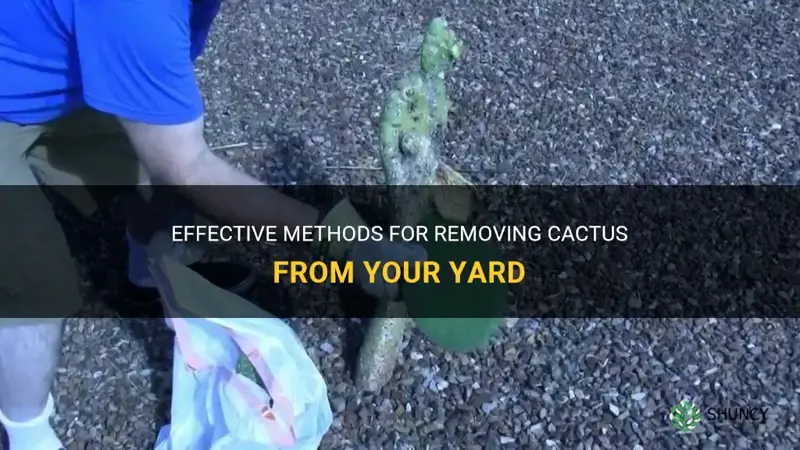When it comes to landscape aesthetics and the health of your garden, a cactus can often present a conundrum. While these spiny succulents can add unique charm to arid environments, there are times when their invasive growth can become problematic. Removing cactus plants from your garden is not just about aesthetics; it’s about restoring balance to your ecosystem. Here, we provide an array of effective methods for removing unwanted cactus from your yard, ensuring that your landscape remains flourishing and pleasing to the eye.
Understanding the nature of cacti is paramount before embarking on the removal process. These plants are designed to survive rugged conditions, which means that their removal may require more than just a standard digging approach. Let us delve into various techniques and strategies that can be employed to effectively eradicate cacti from your landscape.
Identifying the Cactus Species
Before taking any action, it’s crucial to identify the species of cactus you are dealing with. Different species may have varying removal techniques, and some may even have protective regulations in place. Common invaders such as the prickly pear or saguaro have distinct characteristics that warrant specific attention. Familiarize yourself with their morphology—size, color, and shape—as this knowledge is invaluable for effectively managing their removal.
Moreover, understanding the reproductive habits of these plants is essential. Some cacti reproduce through seeds, while others may develop underground tubers. Recognizing these traits can help in devising a strategic removal plan that addresses both the visible and hidden aspects of the plant.
Manual Removal Techniques
For small to moderately sized cacti, manual removal is often the most effective approach. However, caution is required. The thorns of many cacti can inflict painful punctures. Here are some recommended techniques:
Protective Gear
Start by donning appropriate protective gear. Thick gloves, long sleeves, and safety goggles will safeguard you from injury while handling the cactus. The prickly spikes are deceptive; they can easily penetrate skin and cause inflammation.
Using Tools
Utilize tools such as tongs, shovels, and garden spades to assist in the removal process. Grasp the plant firmly at its base and use the trowel to loosen the soil around the roots. Once the soil is enriched with moisture, digging becomes much easier. It is advisable to work the soil thoroughly to minimize root breakage.
When extracting the entire root system, it is imperative to pull straight up. This method reduces the risk of leaving remnants behind that may sprout again. After removal, inspect your garden for any fallen pads or fragments, as these can potentially take root.
Chemical Control Methods
In cases where manual removal proves difficult due to the plant’s size or location, chemical herbicides can be employed. Herbicides containing glyphosate or triclopyr are effective in targeting the cellular structure of cacti. Here are some pointers for successful chemical application:
Application Timing
Choose a warm, dry day to apply the herbicide. The ideal time is late summer or early fall when the plant is actively growing. This ensures maximum absorption and eradication.
Follow Instructions
Adherence to label instructions is critical. Different products will require varying concentrations and application methods. Avoid using more than what is recommended, as this can lead to collateral damage to adjacent flora.
Restoration after Chemical Use
Once chemical treatment has been applied, it is imperative to monitor the area for signs of regrowth. It may take several weeks for the cactus to fully die off. Following this, you may want to consider planting non-invasive species that can outcompete any potential future cactus growth. This not only beautifies the area but also promotes biodiversity.
Alternative Natural Methods
If you prefer non-chemical approaches, several natural remedies can assist in cactus removal. These methods might take longer but prove beneficial for eco-conscious gardeners.
Boiling Water
Pouring boiling water directly onto the cactus can effectively kill it by scalding the plant tissues. This method is particularly useful in smaller species and requires reapplication to ensure complete eradication.
Vinegar Solution
Another natural method is using a vinegar solution. A solution of vinegar and water (in a 1:1 ratio) can be applied directly to the plant. The acetic acid in vinegar draws moisture out of the cactus, leading to desiccation.
Mulching and Ground Cover
Once removal is successful, consider applying mulch or planting ground cover to deter future cactus growth. Dense layers of organic material can suppress any new sprouting and enhance soil quality.
Conclusion
Removing cactus from your garden may seem daunting at first, but with the right knowledge and techniques, it can be accomplished efficiently. Whether you prefer manual labor, chemical means, or natural methods, it is vital to understand the specificities of the cactus at hand. Remember, cacti are resilient, and consistent management is often necessary to prevent re-infestation. By following these outlined strategies, you can create a more harmonious environment in your garden, free from unwelcome prickly intruders.





Leave a Comment